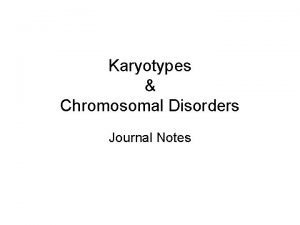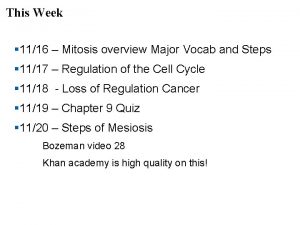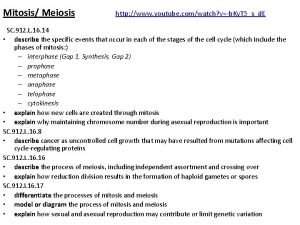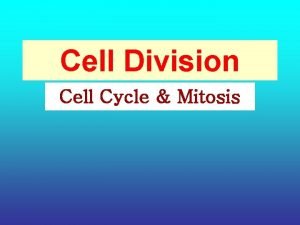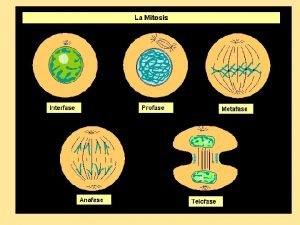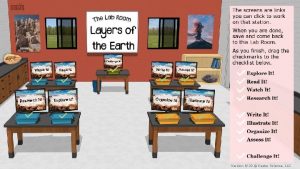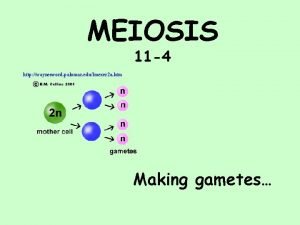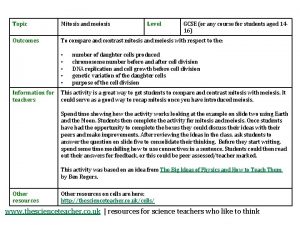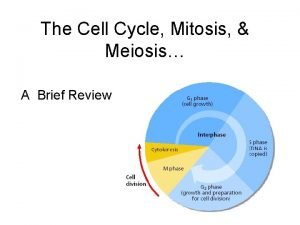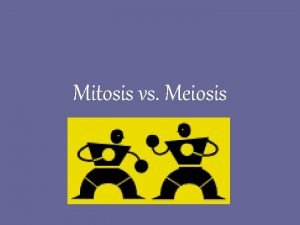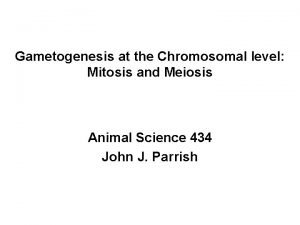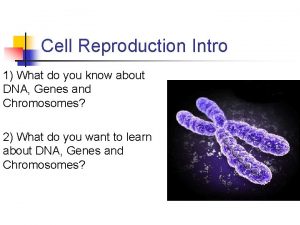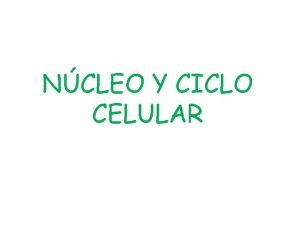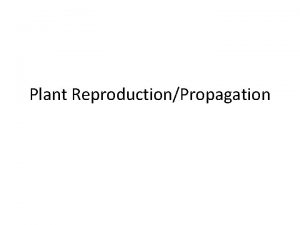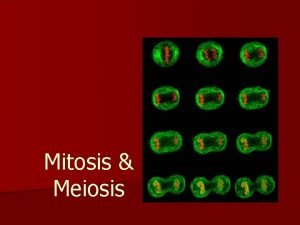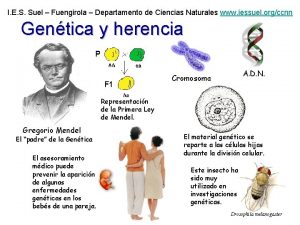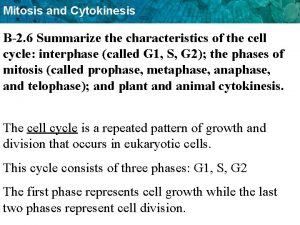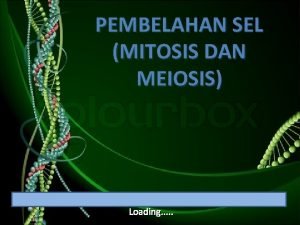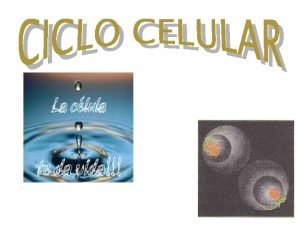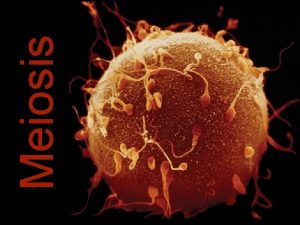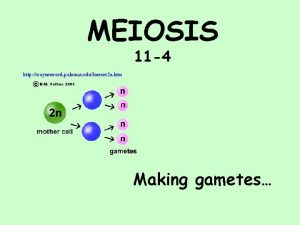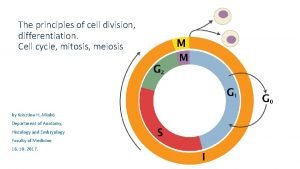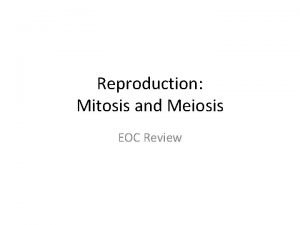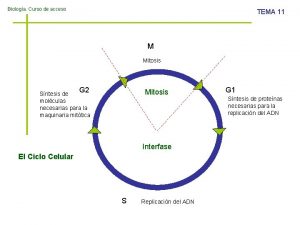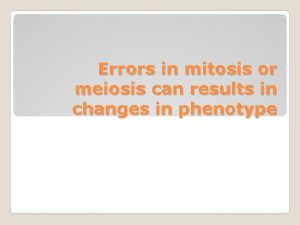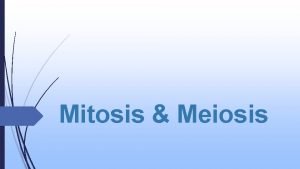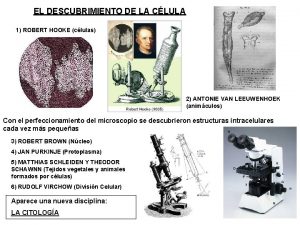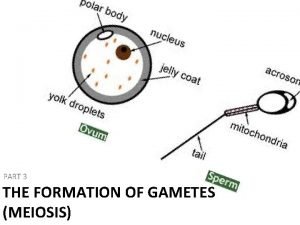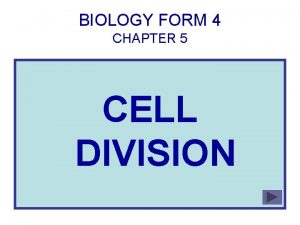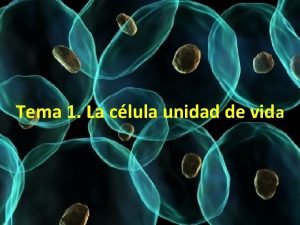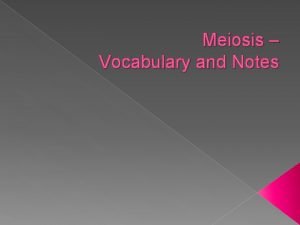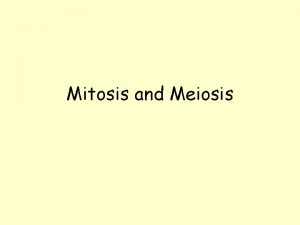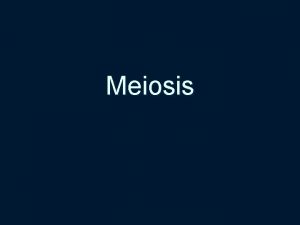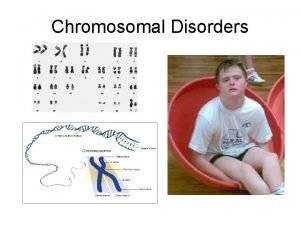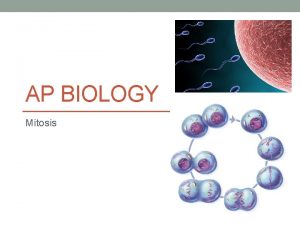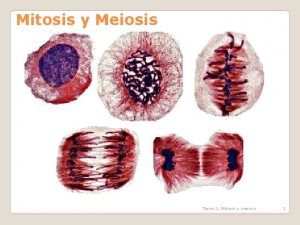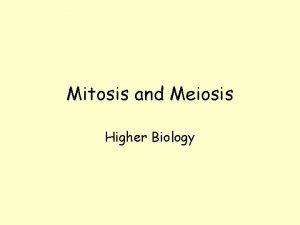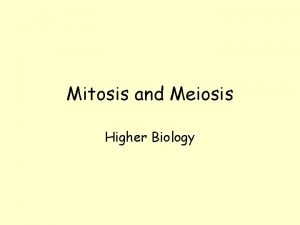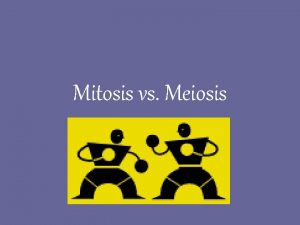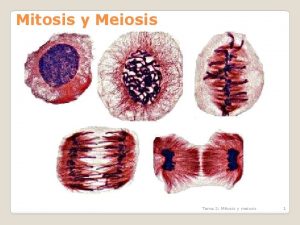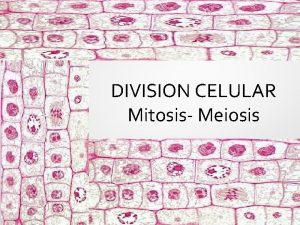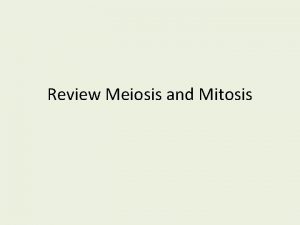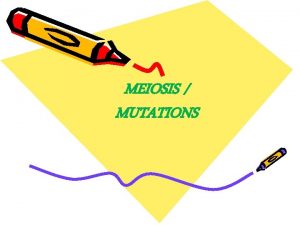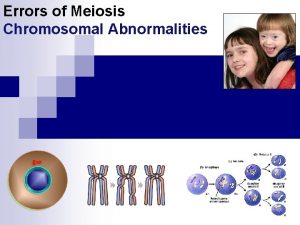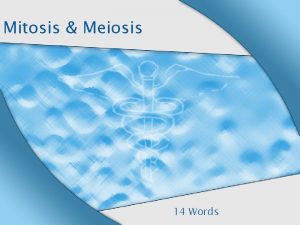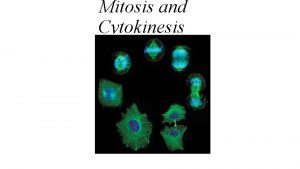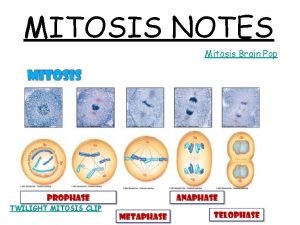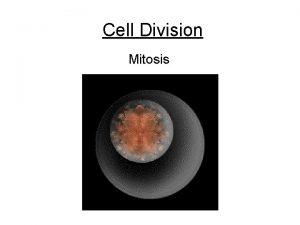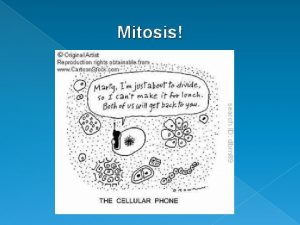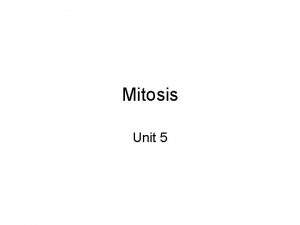Mitosis Meiosis Chromosomal Disorders EQ 1 What is













































- Slides: 45

Mitosis, Meiosis & Chromosomal Disorders EQ 1: What is the difference between Mitosis and Meiosis? EQ 2: What is the difference between haploid and diploid?

DNA is the molecule that transfers hereditary information from one cell to the next. This is a model of the double helix shape of DNA.

When a cell is dividing, DNA winds up tightly and forms chromosomes in the nucleus of the cell. A Copy of DNA is needed in all cells. A specific portion of the DNA is called a gene, which has 1 piece of genetic information. Ex. Hair color is a gene. The genes are contained within the chromosome.

Fill in your diagram!

Mitosis & Meiosis ➢ Mitosis purpose: Copy cell & DNA inside, ex. heal wounds ➢ Meiosis purpose: Make genetically unique gametes that can combine with other parent gamete ex. Make babies

DRAW: MITOSIS When somatic (body) cells reproduce themselves the process is called MITOSIS. Main purposes of mitosis: 1. Growth 2. Repair 3. Asexual reproduction (bacteria) Mitosis leads to the production of two“daughter cells”. Each daughter cell has thesame number of chromosomes as the parent cell. Somatic Cell 2 N 2 N 2 N Daughter Cells ● All cells made by Mitosis are diploid, containing 2 copies of each chromosome (2 N).

MEIOSIS DRAW: When gamete (sperm or egg) cells reproduce themselves the process is called MEIOSIS. Meiosis reduces chromosome # in half. Making Gamete Cells 2 N ● Each cell made by Meiosis contains only 1 copy of each chromosome (n). During meiosis, a single diploid cell divides and produces FOUR genetically different haploid cells. In Meiosis crossing over occurs, where the chromosomes next to each other (homologous chromosomes ) swap genes, this increases genetic variety in the potential offspring. N N

Gametes (n) Made by Meiosis Somatic Cells (2 n) Reproduce (clone) through Mitosis

In animals… Somatic cells (cells of the body) are diploid. This means that each cell has two chromosomes of each type. They are in PAIRS. One from mom and one from dad. These are the cells used to make karyotypes. Made through MITOSIS. Biologists use “ 2 N” to symbolize diploid. Gamete cells (egg, sperm) are haploid. This means that each cell has only ONE of each type of chromosome. Why? Made through MEIOSIS. Biologists use “N” to symbolize haploid.

Mitosis or Meiosis? ? ? • • • 1. Asexual Reproduction? ____ 2. Results in 2 identical cells? ____ 3. Results in 4 non-identical cells? ____ 4. Produces gametes? _____ 5. Results in variation? _____ 6. Results in haploid cells? _____ 7. Used for growth and repair? _____ 8. Skin cells? _____ 9. Sperm cells? _____ 10. Makes 2 N cells? _____

Mom Dad MD Sex Chromosomes: A single pair of chromosomes that determines the gender of the organism. Always put last, pair #23. -Female = XX -Male =XY -Do NOT always match by size- XY! Autosomes: All other chromosomes not involved in gender determination. Pairs #122, Put from largest to smallest. -Matched by same size, like socks! MD M D

Arts & Crafts: Karyotyping No, the chromosomes in your cells are not usually neatly paired up from 1 to 23. First, scientists have to stain the cell and view it with a powerful microscope. They then take a photograph of the chromosomes in the cell, print it out, cut out the chromosomes and find the matching pairs by same size. They then line them up from largest to smallest with the XX or XY at the end.

➢ Meiosis: Crossing Over: Homologous Chromosomes swap (switch) some genes during MEIOSIS only. This creates variety in the gametes. ➢This is why kids who have the same two parents don’t have to look identical, or even alike. Or, conversely, why two siblings might look exactly like their sibling- if they had the same cross-overs.

A karyotype is a picture showing the arrangement of a full set of human chromosomes. We are homologous pair #5! We are the sex chromosomes and we determine the gender -Humans have 46 (23 pairs- half from mom, half from dad) chromosomes -Each pair is called “homologous, ” meaning “same” genes

Practice ➢ Is this karyotype from a male or female human?

Practice ➢ Is this karyotype from a male or female human?

Practice ➢ Is this karyotype from a male or female human?

Fertilization for a diploid offspring Upon fertilization, a “N” sperm meets a “N” egg and a zygote (2 N) is formed. 1 N egg 1 N sperm 2 N zygote

What are chromosomes? ➢ Humans have 23 pairs (2 n=46) of chromosomes, with one chromosome from each parent. The chromosomes are coiled up DNA. ➢ Under normal conditions all of the This i s chromosomes are human a normal k inherited intact and is a pic chromosomaeryotype of ture o s. A k u aryot f p c t hromo o look in pairs. ype som at and c ompar es lined e.

4 Chromosomal Disorders ➢ Deletion: when cells go through meiosis, portions of the chromosome are lost. ➢ Inversion: when cells go through meiosis, parts of the chromosome are flipped. ➢ Translocation: when cells go through meiosis, parts of the chromosomes stick together and switch. ➢ Non-disjunction: when cells go through meiosis the chromosomes don’t separate correctly and either too many or not enough are passed on.

Down Syndrome 1 in 31, 000 births 46 chromosomes XY=97% XX=3% #14/21 Translocation Down Syndrome: Trisomy 90 -95% of Downs cases 1 in 1, 250 births 47 chromosomes XY or XX #21 Trisomy Non-disjunction

Down Syndrome Short, broad hands Stubby fingers Rough skin Impotency in males Mentally retarded Small round face Protruding tongue Short lifespan

Non-disjunction: Turners Syndrome 1 in 5, 000 births 45 chromosomes X only #23 Monosomy Nondisjunction Symptoms: 96 -98% do not survive to birth No menstruation (sterile) No breast development Narrow hips Broad shoulders and neck

Klinefelter Syndrome 1 in 1, 100 births 47 chromosomes XXY only #23 Trisomy Nondisjunction ms d r r a a e e b ers and c r a Sc ing f r e Long le i Ster te skin ility ca Deli ental ab n a m Low al lifesp Norm

Deletion: Cri-Du-Chat Syndrome ➢ 1 in 216, 000 births ➢ 46 chromosomes ➢ #5 Deletion of lower arm : s m e o c t a p f Sym shaped ne o s o a M e is d d e d t r r Hea lly reta nx y ta r n a l e M ed m r n o a f l p a s e M if l l a Norm

Deletion: Aniridia-Wilms Tumor Syndrome ths r i b 0 0 000, 0 , 1 in 50 mes o m o 46 chr XX XY or r arm e p p u f ion o t e l e D #11 ms: rded o t p Sym lly reta d e ta Men h retard t Grow ess ys e n n d d n i i Bl on k s r o Tum lifespan t Shor

Thirteen Q Deletion Syndrome ths r i b 000 , 0 0 5 1 in mes o hrom c 6 4 r XX o arm Y r e X w lo f o n letio e D #13 Mentally retarded Deformed face No thumbs Heart disease Short lifespan

Deletion: Prader-Willi Syndrome 1 in 5, 000 births 46 chromosomes XY=97% XX=3% #15 Deletion of lower arm ead h e k i l d r Small bi rded a t e r y l l Menta blems o r p y r o Respirat Obesity span e f i l t r o Sh

Eighteen Q Deletion Syndrome ths r i b 000 , 0 0 10, 0 n i 1 es m o s romo h c 46 XX r o arm r e XY low f o n tio e l e D #18 Mentally retarded Heart disease Abnormal hands and feet Large eyes Large ears Normal lifespan


Single Chromosome Disorders 1. Deletion • Genetic material is missing 2. Duplication • Genetic material is present twice 3. Inversion • Genetic material is “flipped”

Two Chromosome Disorders (Both types are called “translocation”) Insertion • Genetic material is added from another chromosome Translocation • Material is swapped with another chromosome

Translocation: Burkitt Lymphoma Translocation of the Myc gene on chromosome 8 Normal Myc genes control cell growth and division • Translocated Myc genes don’t function properly • Leads to cancer of the lymph nodes

Cat-Eye Syndrome 1 in 1, 000 births 46 chromosomes XY or XX #22 Deletion of bottom arm es o t and s r nge arded i f ed et Fus tally r Men ll jaw lems a Sm t prob span r Hea al life m Nor

Patau’s Trisomy Syndrome 1 in 14, 000 births 47 chromosomes XY or XX #13 Trisomy Nondisjunction es d y a e e g ll h sin a s i m m S ll or fects a m S de rs t r a ge He n i alia f t i a n r Ext rmal ge rded th r i a o t b n e er Ab ally r t f a t Men palate w weeks t e Clef die a f t Mos

Four-Ring Syndrome 1 in 10, 000 births 46 chromosomes XY or XX #4 Inversion late a p t cend Clef feet s e td Club es don’ n a t Tes t lifesp r Sho

Jacob’s Syndrome 1 in 1, 800 births 47 chromosomes XYY only #23 Trisomy Nondisjunction ? Normal physically Normal mentally Increase in testosterone More aggressive Normal lifespan

Triple X Syndrome Normal physically • Sometimes taller Normal mentally • Inc. risk of retardation Fertile

Other Types of Inherited Genetic Disorder…

Tay-Sachs Multiple kinds of mutation on Chromosome 15

➢ Tay-Sachs ● incidence rate of infantile Tay-Sachs= • Ashkenazi Jewish groups, French Canadian & Cajun: 1 in 30 are carriers • other groups: 1 in 300 are carriers ● ● accumulation of lipids on brain malfunction; death by age 5

Sex-linked: X chromosome ➢ Duchenne Muscular Dystrophy ● 1 boy in every 3, 000 ● progressive weakening of muscles and loss of coordination ● more common in males

➢Cystic Fibrosis ● 1 in 31 is carrier in U. S. ● Single gene mutation ● mucus in lungs, pancreas, digestive tract and other organs ● most common lethal genetic disease in U. S. ● heterozygote may be resistant to typhoid fever

Autosomal Dominant ➢Huntington’s ● ● incidence: 1/10, 000 in U. S. nervous system degenerates ● ● late onset may not show symptoms until past reproductive age

Karyotype Lab “Quiz” Tomorrow ➢ Karyotyping for a disease ➢ Partners ➢ 4 diseases represented, pick 2 karyotypes, cut and match. Once matched up, answer the questions about your two karyotypes.
 Difference between mendelian and chromosomal disorders
Difference between mendelian and chromosomal disorders Non kinetochore microtubules
Non kinetochore microtubules Mitosis and meiosis
Mitosis and meiosis Difference between meiosis 1 and meiosis 2
Difference between meiosis 1 and meiosis 2 Tujuan mitosis dan meiosis
Tujuan mitosis dan meiosis Chromosome sets (=n) in mitosis and meiosis
Chromosome sets (=n) in mitosis and meiosis Anafase
Anafase Kesler science answer key
Kesler science answer key Mitosis and meiosis differences
Mitosis and meiosis differences Metaphase mitosis
Metaphase mitosis Mitosis vs meiosis
Mitosis vs meiosis Mitosis and meiosis
Mitosis and meiosis Meiosis and mitosis images
Meiosis and mitosis images Tetrad meiosis
Tetrad meiosis Mitosis vs meiosis
Mitosis vs meiosis What is meiosis 2
What is meiosis 2 Characteristics of mitosis and meiosis
Characteristics of mitosis and meiosis Nucleolo
Nucleolo Cell cycle
Cell cycle Chromosomes in organisms
Chromosomes in organisms Importance of mitosis
Importance of mitosis Planaria berkembang biak dengan cara
Planaria berkembang biak dengan cara Ies suel biologia
Ies suel biologia Characteristics of mitosis and meiosis
Characteristics of mitosis and meiosis Ciclo celular
Ciclo celular Ciri ciri anafase
Ciri ciri anafase Meiosis y mitosis diferencias
Meiosis y mitosis diferencias Somatic cells vs gametes
Somatic cells vs gametes Meiosis 1 and 2 diagram
Meiosis 1 and 2 diagram Waynesword
Waynesword Prometaphase
Prometaphase Mitosis and meiosis animation
Mitosis and meiosis animation The american buffalo has cells containing 60 chromosomes
The american buffalo has cells containing 60 chromosomes Meiosis
Meiosis Diferencia entre mitosis y meiosis
Diferencia entre mitosis y meiosis Mitosis jeopardy
Mitosis jeopardy Mitosis meiosis
Mitosis meiosis Meiosis concept map
Meiosis concept map Compare mitosis and meiosis using venn diagram
Compare mitosis and meiosis using venn diagram Cuadro comparativo de la mitosis y meiosis
Cuadro comparativo de la mitosis y meiosis Disappear
Disappear Mitosis form 4
Mitosis form 4 Objetivos de un consultorio
Objetivos de un consultorio What is haploid and diploid
What is haploid and diploid Metabolismo celular
Metabolismo celular Meiosis vocabulary
Meiosis vocabulary
